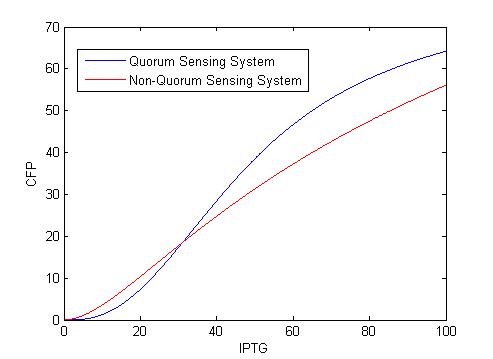Team:Virginia United/Modeling
From 2010.igem.org
(Difference between revisions)
(→Modeling) |
|||
| (7 intermediate revisions not shown) | |||
| Line 86: | Line 86: | ||
</html> | </html> | ||
| - | = Modeling = | + | == Modeling == |
| - | We explored the effect of quorum sensing on the system. Below is a list of equations that were considered in constructing our model. The Arsenic promoter is an example that is used in the following quorum sensing set of modeling equations. In our experiments, we used an IPTG inducible promoter that is upstream of the quorum sensing part and with a downstream cyan fluorescent protein. | + | <!-- We explored the effect of quorum sensing on the system. Below is a list of equations that were considered in constructing our model. The Arsenic promoter is an example that is used in the following quorum sensing set of modeling equations. In our experiments, we used an IPTG inducible promoter that is upstream of the quorum sensing part and with a downstream cyan fluorescent protein. |
| + | [[Image:modeling-formulas.jpg|628 px| center|]] | ||
| + | As seen from the graph below, the predicted response from using a quorum sensing part is a binary response with a bigger difference between the on and off state. The quorum sensing part amplifies the signal as indicated by the blue line. | ||
| + | [[Image:modeling-chart.jpg|552 px| center|]] --> | ||
| + | |||
| + | It is of interest to model the amplification of the signal at steady-state through the use of quorum sensing. The model system used is induced by IPTG through the Plac promoter. We analyze the model at steady-state while varying IPTG. Thus IPTG can be assigned a rate so that it increases as time goes on. | ||
| + | |||
| + | [[Image:Eq1.png|center|]] | ||
| + | |||
| + | This equation is used to describe the dynamics of LuxR production and dimerization, LuxI and its production of AHL, as well as the binding of AHL to LuxR dimers. These are all lumped together in this equation. The first term describes the production of AHL as a function of IPTG from the Plac promoter, the second term describes the positive feedback of AHL production through the Plux promoter, the last term is for degradation. | ||
| + | |||
| + | [[Image:Eq2.png|center|]] | ||
| + | |||
| + | This equation is used to model the output signal (CFP in this case) from the system hooked onto the quorum sensing system. The first term describes the production of CFP as function of AHL through the Plux promoter, the last term is for degradation. | ||
| + | |||
| + | [[Image:Eq3.png|center|]] | ||
| + | |||
| + | This equation is used to model the response from a system that does not have a quorum sensing system attached to it. The first term describes the production of CFP as function of IPTG through the Plac promoter, the last term is for degradation. | ||
| + | |||
| + | [[Image:Eq4.png|center|]] | ||
| + | |||
| + | |||
| + | Performing a steady-state analysis on these equations, with logically assigned parameters, we get the following result. | ||
| + | [[Image:Web_Graph.jpg|552 px| center|]] | ||
Latest revision as of 21:35, 27 October 2010
 "
"


